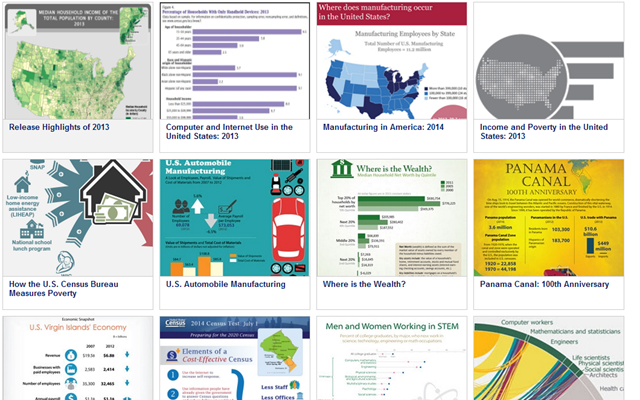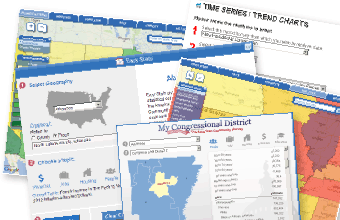Tip Sheet Number 3 — February 7, 2025
Upcoming
2025 Product Calendar
The U.S. Census Bureau has posted anticipated release dates for each regular and recurring statistical product scheduled for release in 2025. These products are listed in the Census Bureau’s online product calendar, which is updated as needed throughout the year.
Demographic
Census Bureau Releases Vintage 2024 Estimates of Population and Demographic Components of Change for Metropolitan and Micropolitan Statistical Areas and Counties, and Estimates of Population for Puerto Rico Municipios
Internet tables and detailed downloadable files will show annual population estimates, rankings and components of population change for metropolitan and micropolitan statistical areas and counties, as well as population estimates for Puerto Rico municipios, since the 2020 Census. (Scheduled for embargo March 11; public release March 13.)
Household Pulse Survey
The experimental Household Pulse Survey (HPS) is an effort by the Census Bureau and other federal statistical agencies to measure how emergent issues are impacting U.S. households from a social and economic perspective.
The Census Bureau has changed the HPS to enhance efficiency and representativeness of the data. Since early October 2024, HPS content has been incorporated into a longitudinal design, with data collection occurring bi-monthly. The longitudinal design will benefit HPS data by allowing direct measurement of change over a longer period in critical elements like spending, inflation, and other social and economic indicators of well-being. The October public-use file was released Dec. 18, 2024; the December 2024 public-use file will be released in February, 2025. With the change to a longitudinal design, the sample size is smaller and data will be released at a national level.
To acknowledge these design changes, the Census Bureau rebranded the HPS as the Household Trends and Outlook Pulse Survey (HTOPS) in January 2025.
Economic
Gridded Environmental Impacts Frame (Gridded EIF)
The U.S. Census Bureau is scheduled to release the Gridded Environmental Impacts Frame (Gridded EIF), a new experimental data product that integrates detailed administrative record and survey data on the U.S. population with high-resolution geospatial information on environmental hazards. Gridded EIF provides detailed demographic counts by age, sex, race and ethnicity; counts of the population by race and ethnicity and household income decile; and exposure data for several key environmental hazards including air pollution. Gridded EIF will enable researchers to conduct advanced spatial analyses while upholding strict confidentiality standards. (Scheduled for release Feb. 11.)
“Exploring the Enhanced Veteran Employment Outcomes Data Tool”
The U.S. Census Bureau and the Local Employment Dynamics (LED) Partnership in collaboration with the Council for Community and Economic Research (C2ER) and the Labor Market Information (LMI) Institute, welcomes David Wasser as he presents, “Exploring the Enhanced Veteran Employment Outcomes Data Tool.” Recently the U.S. Census Bureau released an expanded version of Veteran Employment Outcomes (VEO). The updated experimental data product now includes earnings and employment outcomes for veterans honorably discharged between 2002 and 2021 as well as from additional branches of the U. S. Armed Services. These data show important differences across military rank and occupation, regardless of the branch of service. The Census Bureau partnered with the Department of Defense to update and expand VEO. Earnings and employment outcomes of more than 2.8 million enlisted service members are available. (Scheduled for Feb. 19.)
2024 Annual Business Survey First Look
The U.S. Census Bureau will release new first look data from the 2024 Annual Business Survey (ABS) covering reference year 2023. Data will include estimates on employer business credit use, domestic manufacturing activities, and patent activities by owner characteristics. The ABS is conducted jointly by the Census Bureau and the National Center for Science and Engineering Statistics (NCSES). (Scheduled for release in February.)
Call for Presenters for the 2025 LED Partnership Virtual Workshop – (Deadline: February 18)
Submit your proposal for the 2025 LED Partnership Virtual Workshop set to be held April 8-10! Highlight your work among peer data users with your research on topics including, but not limited to workforce development, economic development, transportation planning, economic analysis and emergency management. We are also expanding to include some of our newest products, including Post-Secondary Employment Outcomes and Veterans Employment Outcomes. Further details and an agenda, when available, will be posted on the LEHD website. Refer to this document for additional proposal guidelines. Keynote speaker will be Ellen Zentner, chief economic strategist and global head of Thematic and Macro Investing at Morgan Stanley. Information on previous workshops can be found at Workshops and Webinars - Longitudinal Employer-Household Dynamics. If you have any questions about the workshop, email [email protected].
Business Trends and Outlook Survey (BTOS)
The BTOS measures business conditions on an ongoing basis. The BTOS experimental data products are representative of all employer businesses in the U.S. economy, excluding farms. The data allow greater insight into the state of the economy by providing continuous, timely information for key economic measures. Data are released biweekly and are available by sector, state, employment size and the 25 most populous metropolitan statistical areas.
Monthly Business Formation Statistics
Business Formation Statistics (BFS) provide timely, high-frequency data on business applications and employer business formations monthly. The data are available at the state, regional and national levels, and by industry sector at the national level. The next monthly BFS will be released Feb. 12 and will include January 2025 data. Business Formation Statistics - Release Schedule (census.gov).
Recently Released
(Released since Jan. 24, 2025)
Webinar on New Disclosure Avoidance Principles — Jan. 28
The U.S. Census Bureau held a webinar covering our new framework for evaluating the strengths and limitations of different applied disclosure avoidance systems. Visit the Disclosure Avoidance Webinar Series page for recordings, transcripts and slides for all disclosure avoidance webinars.
Census Bureau Releases 2023 Community Resilience Estimates and Natural Hazard Risk Ranking Tables — Jan. 30
The U.S. Census Bureau released the 2023 Community Resilience Estimates, which highlight socially vulnerable areas in the United States. Featuring a new interactive tool, this release includes seven ranking tables per geographic level, highlighting the nation’s most socially vulnerable counties (top 25) and census tracts (top 100) in the following context: winter weather risk areas (i.e., snow, sleet and freezing rain); flooding risk areas (i.e., coastal flooding and riverine flooding); hurricane risk areas; strong wind risk areas (i.e., damaging winds exceeding 58 mph); wildfire risk areas; and earthquake risk areas (new for 2023 CRE).
American Community Survey
2019-2023 American Community Survey 5-Year Citizen Voting Age by Race and Ethnicity Special Tabulation — Feb. 7
The U.S. Census Bureau released the 2019-2023 American Community Survey 5-Year Citizen Voting Age by Race and Ethnicity (CVAP) Special Tabulation. This special tabulation is created for use in voting rights analysis and is published for a series of geographies, down to block-group level. Publication of this special tabulation is only available for download from the Census Bureau Citizen Voting Age by Race and Ethnicity webpage.
Demographic
Census Bureau Releases Updated Estimates from NEWS Project — Jan. 29
The U.S. Census Bureau released new findings from its National Experimental Well-Being Statistics (NEWS) project. NEWS is a research-driven project to improve how the Census Bureau measures income and poverty. NEWS does this by exploring new methods for creating these economic “well-being” indicators by looking back at data collections from previous years, using a wider range of data sources and applying new advanced analysis techniques.
Economic
2022 Comparative and Bridge Statistics Reports — Feb. 6
The U.S. Census Bureau released new comparative and bridge statistics reports for the 2022 Economic Census this week. These reports allow for a comparison between the current and previous economic censuses where there have been North American Industry Classification System (NAICS) changes. Data include the number of firms, establishments, employees, sales, and annual and first-quarter payroll.
Facts for Features
National Black (or African American) History Month: February 2025 — Dec. 11
To commemorate and celebrate the contributions to our nation made by people of African descent, the U.S. Census Bureau presents a collection of demographic and economic statistics about the Black community.
America Counts: Stories Behind the Numbers
America Counts tells the stories behind the numbers in a new and inviting way. We feature stories on various topics such as families, housing, employment, business, education, the economy, emergency preparedness and the population. New stories include:
Stats for Stories
Stats for Stories provides links to timely story ideas highlighting the Census Bureau’s newsworthy statistics that relate to current events, observances, holidays and anniversaries. The story ideas are intended to assist the media in story mining and producing content for their respective audiences.
Resources
Emergency Management/Disaster Resources
When major disasters strike, visit our Emergency Management webpage for demographic and economic data on impacted areas. Each disaster will include data from our key emergency management tools: OnTheMap for Emergency Management, Community Resilience Estimates, Census Business Builder: Regional Analyst Edition, and other useful resources.
Learn What Surveys Are Being Conducted in Your Community
Discover which of the U.S. Census Bureau’s 130-plus annual surveys are being conducted in your community. In a variety of surveys and censuses, evolving from the first census in 1790, the Census Bureau provides official information about America’s people, businesses, industries and institutions. Learn more about surveys currently being conducted in each Census Bureau region:
Data Tools
Below are a few of the U.S. Census Bureau’s interactive applications used to access statistics from our 130-plus annual surveys. A complete list can be accessed on the Census Bureau’s Data Tools and Apps webpage.
FRED® Economic Data
The U.S Census Bureau’s publicly available data sets and tools to assist in the equitable distribution of resources, and identifying underserved communities.
Job-to-Job Flows Explorer
Analyze the Job-to-Job Flows (J2J) data through interactive charts, maps and tables.
PSEO Explorer
Visualize the experimental Post-Secondary Employment Outcomes (PSEO) data through interactive bar charts and Sankey diagrams.
Training Opportunities
Census Bureau Training Opportunities
Webinars are available on a regular basis to help the public access and use Census Bureau statistics. These free sessions, which are 60 to 90 minutes each, show users how to navigate Census Bureau databases and mapping tools and find demographic and economic statistics at the local or national level. Descriptions of upcoming sessions are available on our Census Academy webpage. Login details are provided at least one week before a webinar.
- A Starting Guide to Income and Poverty Data
(Thursday, Feb. 13, 2-3 p.m. ET) - Exploring the Enhanced Veteran Employment Outcomes Data Tool (Wednesday, Feb. 19, 1:30-2:45 p.m. ET)
- Discovering the American Community Survey 1-Year Supplemental Estimates (Wednesday, Feb. 26, 2-3 p.m. ET)
- Understanding American Community Survey Tables and Profiles (Wednesday, March 26, 2-3 p.m. ET)
Archived Training Resources — Visit the Census Bureau’s Educational Resource Library for previously recorded, free training available at your convenience. The library includes presentations, recorded webinars, tutorials and other helpful materials.





